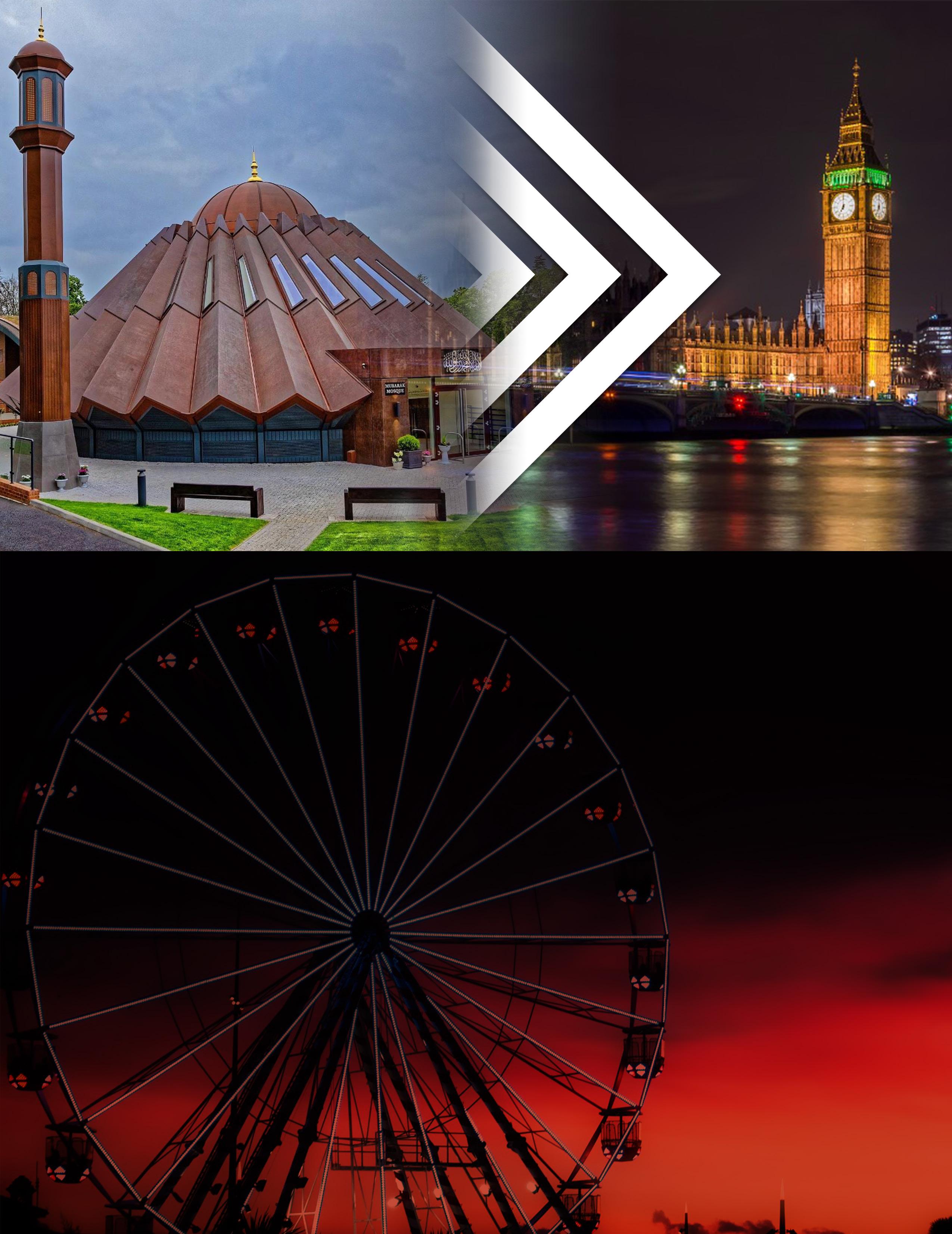
13 minute read
How Islam Transformed England
Written by | by Nauman Hadi, Missionary UK
Plight of England before the 16th Century
Have you ever wondered how London got those fascinating colossal buildings, architectural masterpieces which remind you of the days of Rome? It’s strange when we come to think how a city which was congested with poorly built houses laden with disease and poor sanitation, but the centre of which were just a few Gothic buildings not only became a thing of architectural awe but boasted the administrative machinery of an empire behind those walls. England was the hub of religious intolerance during the medieval era, plagued with superstitious belief which heavily influenced its laws. As for intellectual advancement it too followed the footsteps of the Church in declaring the Scripture as the only path that one needed to explore. By the 16th century England
was not special in any way. It was a small island compared to others isolated on its own compared to the Catholic empires of France and Italy. So how does an empire arise from nothing? The answer is Islam. Islam was responsible for the amazing transformation that turned a country slowly being devoured by its enemies; both internal and external, to an economic, cultural and social hub of the known world. And it all took place during the reign of Queen Elizabeth I. As this article aims to compare two periods of time in order to determine the grandeur of the pivotal force- Islam, it is befitting that we examine what England was actually like before the reign of Queen Elizabeth I in detail. It is quite difficult to sum up the progress of a nation which took hundreds of years and saw countless pivotal moments in just a few paragraphs. ISMAEL MAGAZINE | 29
However, I shall confine myself to paint only one image from which the reader can ascertain what England was before the 16th century, or in other words before the reign of Queen Elizabeth. As the reader is aware the history of England as a nation begins when the Romans abandoned it leaving it to be ruled by tribal warlords. Though small kingdoms were established but a complete nation had not yet come into existence. The economy of the country was in tatters and there was no single identity that could be classed as being strictly ‘English’. It took centuries of Germanic migration to see the beginnings of various cultures which transformed into kingdoms that began to compete for power. England remained in this condition till 1066 when the Battle of Hastings took place and replaced the Anglo-Saxon elite with French and Norman nobility. William the Conqueror took over and replaced the existing tribal system by a system of controlling the population through castles scattered throughout the land. The next few centuries saw no accelerated development of the intellect of the nation, as continuous rebellions broke out and the country was plagued with religious conflict. Furthermore, tensions between the elite saw civil wars break out resulting in the loss of Normandy. In short, England along with her allies and enemies in Europe was not in good health.
The Tudor Period
Later on during the emergence of the Tudor House due to an increase in population and the Church’s support of King Henry VII, economic advancements were made. However, the country was about to undergo a massive problem which would create such disorder that history would remember the perpetrators with the euphamism ‘bloody’. In the years following
King Henry VII’s demise, his son’s rule would tragically alter the course of history. Henry VIII was to create such disorder in society that perhaps seldom occurs in history. The separation of the Church of England from the Catholic Church resulted in killing of thousands of innocent people as Catholic churches and monasteries were looted and confiscated by the crown. It is estimated that around 72,000 people were killed during the reign of King Henry VIII . This created great upheaval in the country as the Crown’s focus on personal issues left other areas of the nation’s wellbeing to fall into decline. During a time when the monarch had absolute power it was up to him or her to ensure that the country was making progress, economically, socially and intellectually. However, as the King was busy attending to his fantasies about marrying newer and newer Queens in order to obtain a worthy heir to the English throne, the country suffered. Not only was there an air of dismay amongst the English people about the tragic separation from the Church but tensions were now rising between Catholics and Protestants. King Henry VIII died in 1547 after ruling for 37 years and his son Edward IV was crowned King. However, he was an ill child coming into power at the age of 9 and passing away 6 years later. However, it is the daughter of King Henry VIII: Mary whose rule we must examine to understand the condition of the country. History remembers Queen Mary as ‘Bloody Mary’ for the sheer amount of Protestants that she burnt at the stake. She restored protestantism after years of break-up with the Church and seems as though spent her entire life trying to accomplish this task. In the first month of her rule she issued a declaration stating that she would not force any of her subjects to convert to her religion, but a ISMAEL MAGAZINE | 30

few weeks later leading protestants in the country were in prison . It was not long before the string of burnings at the stake began to cause an outcry across Europe. Queen Mary’s hands were occupied dealing with religious opposition which lead to hardly any progress. Despite Queen Mary’s marriage to Phillip of Spain England did not benefit from trade between the two countries even though Spain had accessed wealth from newly discovered America and could have opened an entire spectrum of progress for England.
Queen Elizabeth I of England
We now turn our attention towards the Queen who changed everything, who initiated the ‘Golden Age’ for the country and forever ensured England would be seen as a real power within Europe. Queen Elizabeth was Protestant, though we still find reports of Catholics being executed during her rule, but her rule was more tolerative towards other creeds. Historians often regard her reign to be one of a renaissance which that inspired national pride through classical ideals, international expansion, and naval triumph over the Spanish. In terms of the entire century, the historian John Guy (1988) argues that England was economically healthier, more expansive, and more optimistic under Queen Elizabeth’s rule than it had been for a thousand years. This ‘golden age’ represented the apogee of the English Renaissance and saw the flowering of poetry, music and literature. The era is most famous for theatre, as William Shakespeare and many others composed plays that broke free of England’s past style of theatre. It was an age of exploration and expansion abroad, while back at home, the Protestant Reformation became more acceptable to the people, most certainly after the Spanish Armada
was repulsed. It was also the end of the period when England was a separate realm before its royal union with Scotland. England was also well-off compared to the other nations of Europe. The Italian Renaissance had come to an end under the weight of Spanish domination of the peninsula. France was embroiled in its own religious battles due to significant Spanish intervention, that would only be settled in 1598 with the Edict of Nantes. In part because of this, but also because the English had been expelled from their last outposts on the continent by Spain’s Tercios, the centuries-long conflict between France and England was largely suspended for most of Elizabeth’s reign. Economically, the country began to benefit greatly from the new era of trans-Atlantic trade, persistent theft of Spanish treasure, and the African slave trade. In short, this was a time when England really began to take shape into the current day majesty that we see it as in the streets of London. But the question is, how? For centuries England had been in a deplorable state, wars, refomations, execution, civil unrest, social upheaval. Why did England transform during the time of Queen Elizabeth I? On a May morning in 1570 a papal bull, nailed to the door of the Bishop of London’s palace, sealed Protestant England’s break with Catholic Europe. Europe was Catholic, Spain was England’s bitter enemy and now the Vatican too had joined the list. Elizabeth was left alone, so she turned to Islam. There is no question that Jerry Brotton’s exploration of ‘a much longer connection between England and the Islamic world’ is generally appreciated has currency. In the following pages I will prove how it was inspiration from Islam that lead to the Golden Age of Britain, how Queen Elizabeth ISMAEL MAGAZINE | 31

I sent letters to the Islamic world asking for trade and the manner in which she transformed her country being impressed by what she found in the Muslim lands. From the moment of her accession to the throne in 1558, Elizabeth began seeking diplomatic, commercial and military ties with Muslim rulers in Iran, Turkey and Morocco — and with good reasons. Soon, the might of Catholic Spain was against her with an invasion imminent. English merchants were prohibited from trading with the rich markets of the Spanish Netherlands. Economic and political isolation threatened to destroy the newly Protestant country and Elizabeth was in need of dire help. Elizabeth responded by reaching out to the Islamic world. Spain’s only rival was the Ottoman Empire, ruled by Sultan Murad III, which stretched from North Africa through Eastern Europe to the Indian Ocean. The Ottomans had been fighting the Habsburgs for decades, conquering parts of Hungary. Elizabeth I hoped that an alliance with the Sultan would provide much needed relief from Spanish military aggression, and enable her merchants to tap into the lucrative markets of the East. For good measure she also reached out to the Ottomans’ rivals, the Shah of Persia and the ruler of Morocco. “Neither the earth, the seas, nor the heavens, have so much force to separate us, as the godly disposition of natural humanity, and mutual benevolence have to join us together’’ She wrote to the Shah of Persia in 1561. She clearly wanted to build as many bridges as she could but not with her Christian counter – parts but with the Muslims. She managed to establish firm trading routes with the Muslim rulers, with ambassadors and emissaries travelling to and from
England. This new trade alliance brought in a steady flow of cash which Elizabeth used to fund expeditions to the distant lands in order to establish trade. The famous East India Trading company was from among a list of such expeditions which would later go on to conquer the entire subcontinent helping the supremacy of the British Empire. The Barbary Company and The Turkey Company, too were given Royal Patent to open trade with Morocco and Turkey. Queen Elizabeth I was being strangled by dwindling trade alliances which was crucial to the country’s economy. It was the trade alliances made with the Muslim states such as the Turks which not only granted the country a breath of relief but accelerated trade to such a pace that England was now able to fund huge expeditions abroad. Hence, it was not only trade with the Muslims, but also friendship with them which enabled Queen Elizabeth I to save her country. The economy back at home began to improve as well. London became architecturally transformed as new offices pertaining to international affairs began to be established. In fact we even find accounts of the Queen trying to push the ‘removal of the vice of usury’ in order to build a stable economy. This too was inspired by the common ground that Elizabeth tried to find with the Muslim rulers she was trading with. The feeling of financial well-being was made clear in 1576 in a speech to Parliament by Sir Walter Mildmay who was the chancellor of the Exchequer at the time: “(Elizabeth) had inherited a realm miserably overwhelmed with Popery, dangerously afflicted with war, and grievously afflicted with debts; the burden of which cannot be remembered without grief. Her Majesty ISMAEL MAGAZINE | 32

hath most carefully delivered the kingdom from a great and weighty debt, wherewith it hath long been burdened. The realm is not only acquitted from this great burden but also her Majesty’s credit thereby both at home and abroad greater than any other prince for money”
Intellectual Advancement
The Elizabethan era saw the rise of the English Renaissance as the British came into contact with an entire spectrum of arts from the Islamic World. We should remember that by the 16th century Islam had already seen an array of scientists, mathematicians and intellectuals which outweigh those in the West. Elizabethan England, when it came into contact with such a rich intellectual culture, began to absorb and access the knowledge that the Muslims had been enjoying for centuries. Furthermore, the oversea expeditions not just during Queen Elizabeth I’s rule but for centuries after, that were triggered due to trade with Muslims were the primary source of gaining new knowledge. The skill of circumnavigation enabled many sciences to further develop as it allowed empirical examination. Charles Darwin, though he appeared later, cannot have conducted his research into evolution without travelling to distant parts of the world. Hence, the intellectual advancements made during the time of Queen Elizabeth I were made possible due to the English access to Muslim knowledge alongside Muslim trade generating economic possibilities leading to exploration. What is interesting to note is the communication which took place between the rulers of the Muslim lands and Elizabeth gives us a detailed description of how Islam was viewed by her. In one of her letters she wrote: she was ‘the most invincible and most mighty defender of the Christian faith against all kind of idolatries’ . This lead to thousands of English traders entering into Muslim lands, enjoying such safety which they would never receive in Europe, especially since the Inquisition was ablaze. Queen Elizabeth I also believed that Islam was more common to Protestant belief than it was to Catholicism. The sugar, silks, carpets and spices transformed what the English ate, how they decorated their homes and how they dressed. Words such as ‘candy’ and ‘turquoise’ (from ‘Turkish stone’) became commonplace. Even Shakespeare got in on the act, writing “Othello” shortly after the first Moroccan ambassador’s six-month visit. The Country was being transformed into something that had never been seen before. Prosperity was rising, people were turning towards poetry and intellect was growing. Take a moment to admire the paintings from that era (1600-1540) and you will find that the monarchs and noblemen are wearing silk from Turkey, or have pearls in the background. In short, it was simply due to the contact with Islam that opened doors for Queen Elizabeth enabling her to accelerate the economic, political, intellectual and architectural progress of her country. In essence she learnt many arts from the Muslims which she introduced to her countrymen leading to cities like London taking place at the forefront of advancement in a new kind of renaissance. Whether people believe this or not, but Islamic culture did indeed bring about the change that was so much needed to bring England on the right track; a track which would create an empire upon which, the sun never set.






